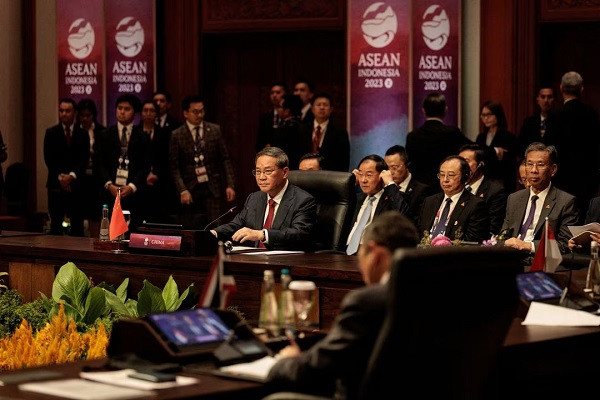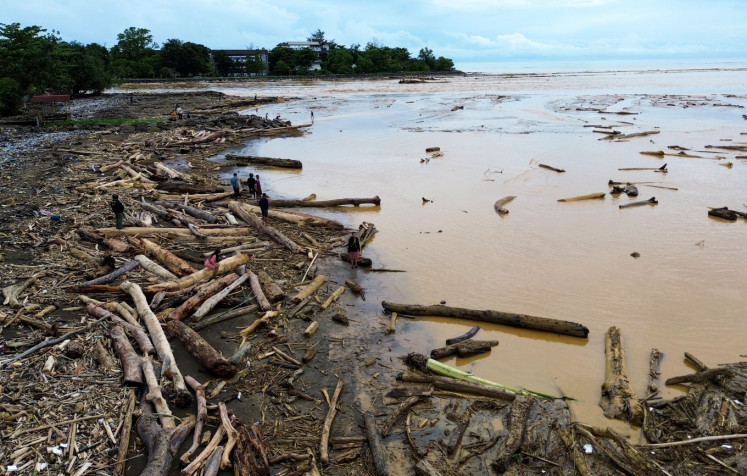Popular Reads
Top Results
Can't find what you're looking for?
View all search resultsPopular Reads
Top Results
Can't find what you're looking for?
View all search resultsASEAN centrality and unity have never been this important
While member states may be aligning with one or the other power, ASEAN as a group must remain neutral, lest it forfeit its centrality.
Change text size
Gift Premium Articles
to Anyone
T
he East Asia Summit in Jakarta on Thursday may be missing several key world leaders, particularly President Joe Biden of the United States and Xi Jinping of China, but the importance of this annual forum cannot be overstated when it comes to the future of the Indo-Pacific region, increasingly embroiled in big-power rivalry.
Here, more than anywhere else in the world, is the battleground in the contest for power and influence between China and the US. The growing tension is already impacting international relations. And it could get worse.
There are potential flashpoints in the region, Taiwan and the South China Sea in particular, that could lead to military clashes. The specter of World War III, and the use of nuclear weapons, is all too real.
Southeast Asia, which straddles the Indian and Pacific oceans, is right in the firing line. It would be among the first casualties of such a war. ASEAN must use all at its disposal to deescalate the current tension and prevent that war from erupting.
The East Asia Summit, an annual gathering hosted by ASEAN since 2011, provides the perfect forum for ASEAN to show its diplomatic mettle. Besides the 10 ASEAN member states, the East Asia Summit brings in leaders from Australia, China, India, Japan, New Zealand, South Korea, Russia and the US.
There is no other forum, outside the United Nations, that brings leaders from big powers together like the East Asia Summit. This presents ASEAN, and Indonesia as its chair this year, with an opportunity to play their parts in ensuring peace, stability and prosperity for the region and beyond.
The Indo-Pacific is where the rivalry between China and the US is being played out. While one is trying to assert its growing power, and the other is trying to contain it.
One thing for sure is that China’s rise is no longer perceived as peaceful, as it was in the first decade of the millennium. The military build-up, including but not only in the South China Sea, is a major concern to all about how it would use this newfound power. The Belt and Road Initiative, in which China invests heavily in infrastructure projects in countries spreading from the Pacific islands, through mainland and maritime Asia, the Middle East, the Horn of Africa and all the way to Europe is also seen as China exercising its hegemonic power.
The US came up with its Indo-Pacific Strategy last year clearly designed to contain, or deter, China’s power and influence. It has also formed alliances like the Quad (with Australia, Japan and India) and AUKUS (with Australia and the United Kingdom) to strengthen its presence in the region, in addition to old alliances with Japan, South Korea, the Philippines and Thailand.
Other countries, including distant European powers, have come up with their own Indo-Pacific policies, reflecting the geopolitical strategic values of the region to many countries.
China has refused to use the term “Indo-Pacific”, preferring the older “Asia-Pacific”, but semantics aside, it is building its maritime and economic strengths in the Indian Ocean, as well as the Pacific Ocean.
The ASEAN Outlook on Indo-Pacific (AOIP) is the group’s answer to this turn of events. While modest in substance, it is ambitious in its goal: to turn the Indo-Pacific into a region of cooperation. The principles in the outlook include rules-based policies, transparency and inclusivity, meaning that everyone, including China, is included. This contrasts with most other Indo-Pacific concepts that try to exclude China.
ASEAN countries have a strong reason to get China on board not only because it is their biggest economic partner. Several member states have territorial disputes with Beijing in the South China Sea. Diplomacy is still the way forward for ASEAN as it is negotiating with China for a binding Code of Conduct in resolving these disputes, which would include refraining from the use of power. Getting China to sign this document would go a long way to reducing tensions in the region.
Underpinning the AOIP is ASEAN centrality in the Indo-Pacific region, and this was already recognized by all the major powers even before the AOIP came into being in 2019. The attendance of big powers in many ASEAN forums, including the ASEAN foreign ministers’ meetings, the ASEAN Regional Forum, and in the Asia Pacific Economic Cooperation (APEC), attest to the group’s role in regional and international affairs.
This centrality however is contingent upon ASEAN as a group remaining neutral in the Sino-US rivalry. While member states may be aligning with one or the other power, ASEAN as a group must remain neutral, lest it forfeit its centrality.
ASEAN, though, is not without internal challenges that raise questions about its unity, and therefore its effectiveness in playing a central role in the region.
One issue that is dividing the group is the membership of Myanmar since the military seized power in 2021 and ruled the country by killing and brutally suppressing its people. For now, Myanmar has been excluded from all high-level meetings, but the issue is already dividing ASEAN, and raising questions about ASEAN’s relevance if it cannot put its own house in order.
In his speech opening the 43rd ASEAN Summit in Jakarta on Tuesday, President Joko “Jokowi” Widodo rallied his counterparts to stay united even when they hold different opinions.
“I have been hearing questions whether ASEAN will break up and lose its unity, and whether the ASEAN ship can continue sailing,” he said. “I have to reiterate that ASEAN unity remains intact. Unity should not be equated with a lack of difference of opinions.”
Given the challenges externally and internally, ASEAN centrality and unity have never been this important.
***
The writer is senior editor at The Jakarta Post.











